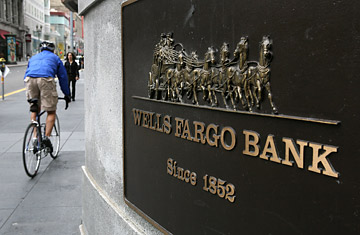
A bicyclist rides by a Wells Fargo branch in San Francisco
It may be time for investors to get off the Stagecoach.
Shares of Wells Fargo, which uses a red horse-drawn carriage as its corporate mascot, have risen nearly 200%, to $24 per share, in less than three months. And while the stocks of all banks are up over that period, Wells Fargo's increase is more than double the rise of the KBW Bank Index. As a result, Wells' shares are starting to look pricey — and the bank is still facing tens of billions of dollars more in loan losses in the next two years.
Analyst Ed Najarian, who follows bank stocks at independent research firm ISI Group, says Wells will weather the current economic crisis better than its rivals, but that investors shouldn't take much comfort in that. "We think Wells' earnings may be lower than expected in the second half of this year as credit losses rise and mortgage-origination revenue declines," says Najarian, who rates Wells shares a "hold." (Watch TIME's video of Peter Schiff trash-talking the markets.)
To be sure, Wells Fargo still has plenty of fans, and its bottom line has held up better than expected — the bank's first-quarter earnings of $3 billion were up 50% over the prior year's first quarter, despite a tough economy. Executives at Wells are also reassuring investors that the bank's loans will perform better than rivals; they point to the $39 billion in loans the bank wrote off when it acquired Wachovia last fall as proof of its conservative posture.
At least one prominent investor thinks Wells is doing something right. Warren Buffett's Berkshire Hathaway bought nearly 12.4 million shares of Wells Fargo stock in the first quarter, upping its stake to just over 300 million shares. In early May, Buffett told attendees at his firm's annual meeting that he thought Wells was well capitalized and had a competitive advantage over other banks. (Read "My $650,100 Lunch with Warren Buffett.")
But Buffett and other investors may be putting too much faith in the bank management's ability to gauge future loan losses, something no major bank has gotten right during this downturn. And if there's even a bit of disappointment, Wells Fargo shares have further to fall than its rivals. The stock trades at a price-to-book multiple of 1.6; JPMorgan, another bank deemed to be in relatively good shape, has a price-to-book of just 1. On earnings, Wells trades at 16 times its expected bottom line this year. That's better than even Goldman Sachs, which has a price-to-earnings multiple of just 13.
With unemployment rising and house prices continuing to fall, Wells' unpleasant earnings news could persist past the end of the year. Bank examiners in the recent government stress tests estimated that Wells Fargo will have as much as $86 billion in loans that go unpaid over the next two years. The bank has already put aside some money to cushion that blow — $22 billion as of the end of March — and Wells would be able to tap another $24 billion of loss provision that it set up when it acquired Wachovia. But that still leaves another $40 billion in loan losses that could find their way to Wells' bottom line in the next two years.
A greater threat to investors springs from the fact that Wells Fargo's loan losses could exceed the government's expectations. In calculating the stress tests, government bank examiners applied different loan-loss rates for different banks. For instance, bank examiners were relatively tough on Wells' primary mortgage-loan portfolio, predicting that nearly 12% of the loans would default over the next two years. This compares to an estimated loss for Citigroup of just 8% for its primary mortgage loans. That makes sense. More of Wells' mortgage loans are concentrated in California than Citigroup. And California has had more foreclosures than any other state. (Read "Can Marijuana Help Rescue California's Economy?")
But on commercial real estate loans, it was just the opposite, as bank examiners were particularly easy on Wells Fargo. The government estimated that even if the economy turns worse, slightly less than 6% of Wells' commercial real estate loans would default this year and next, which was much less than the industry average expected loss of as much as 12%. Some economists think it will be even worse than the government thinks. New York University economist Nouriel Roubini estimates that as much as 17% of commercial real estate loans could eventually go unpaid. Regulators wouldn't say why the government predicted that Wells' commercial loan portfolio would perform better than other banks. But if it doesn't, Wells' bottom-line losses could be a big negative surprise. If Roubini's estimates are right, Wells could have an additional $19 billion in commercial loan losses.
"While [Wells'] management's efforts to 'de-risk' Wachovia's problem loans may help in the near term, we still expect losses to exceed management's expectations," wrote analyst Paul Miller, who follows banks at FBR Capital Markets, in a recent report to clients. Miller, who rates Wells' shares "underperform," expects Wells' stock to fall by half its current price to $12. "Given our macro outlook ... we just can't get comfortable with Wells' balance sheet."
